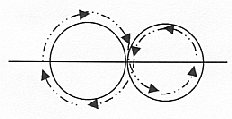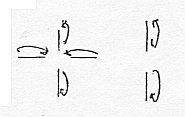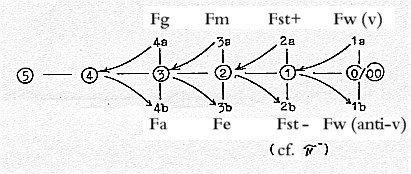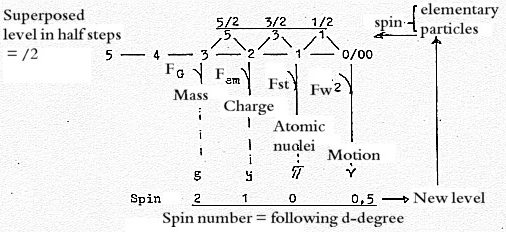|
What is Spin ?
Physicists seem to have difficulties describing - or deciding
- what this property of elementary particles is - in reality.
This could leave the field free for some guesswork!
Still, the mathematical definition is clear, and here are
some aspects of physicists in different sources:
1) Spin is not really a movement of rotation;
it should be physically false to say it was. This is emphasized.
2) Spin is defined as a kind of angular momentum
of elementary particles, in a direction where this is maximal. It
gets the same physical quantity as h, (Js), Planck's
constant, and is quantified
in a way which makes it either an integer of the expression
h/2π
or one-half of it.
This quantum number for elementary particles was invented
by Pauli to explain his "exclusion principle":
the fact that no two electrons in an atom can have all properties
in common.*
The spin quantum number is expressed in
units of
h/2π.
* This Pauli exclusion principle, essential in modern physics,
could in the dimension
model here be interpreted as an expression for the
fundamental postulate of polarizations through a dimension
chain. Cf. all other quantum numbers in e-shells.
3) According to Hawking (later readings)
spin concerns the view of an observer and expresses how
much a particle or quantum has to be rotated to look the
same again: half a rev, 180°, (or less), or 1
rev, 360°, or 2 revolutions. The latter implies the
quantum number 1/2 (for fermions), which gives the quantum
number h/4π,
4 π
= 2 times the circumference of a circle, 720°.
4) According to the physicist Newman spin
can be put in connection with a centrifugal force and a
Coriolis force. (No more said about this in the reference.)
Rotation in the form of structure?
Is it possible to unite these different aspects?
(Some parts from the page about Charge
repeated here.)
In some way it sounds like the invisible
blood system in animals, developed from a simple string
to a doubled system to heart and lungs in higher animals.
We could start with a suggestion that spin is a kind of
rotation form of the structure itself, which should be in
accordance with Hawking's view: the form possible to analyze
as shaped by bound motions.
It would agree too with the general aspects in the dimension
model here:
With analysis optional, structures as
assumed 2-dimensional "particles" would be possible
to analyze in terms of motions too, or 1-dimensional curves
as potentials with direction.
0/00←1← 2← 3←4←5 degree
of Motions
5 →
4→ 3 →
2 → 1 →
0/00 d-degree of Structure,
With the view on atomic "particles"
born out of "inverted" vector fields and forces,
it's not astonishing to find concepts as momentum and direction
appropriate for the structure itself.
The spin numbers 2 - 1 - ½ also
supports the idea of halvings in the hypothesis
about angle steps - but in opposite direction than
presumed in the Presentation in connection with structures!
From 180° (graviton) to 360°→
(photon) to 720°→ (fermions,
the more "material" particles). Yet, this could
be said to imply a way towards a stepwise more specified
direction according to the postulated principle in this
model.
Suppose motions, doubled, form 1-dimensional potentials
- or "vector lines" - which were attributed motions
in 4 d-degrees according to our simple postulates:
Rotation is a 2-dimensional motion, and
an "impossible" or imaginary, simultaneous rotation
in two different planes, or complementary directions, could
perhaps express such a 4-dimensional rotation of the structure?
Each curved surface or wave form has an inside and an outside
- as complementary"poles". A simple sine wave,
one wavelength and return, can illustrate how a particle
has to be turned 2 revolutions (720°) to come back to
the same "starting point again", or look the same
again (From page about Charge.)

It means that the fermions with spin 1/2 could be interpreted
as a combination of the complementary poles of d-degree
2 (as "inside" and "outside" here, or
"convex-concave"). One revolution to the right,
one inside to the left. Opposite directions of the revolutions
should represent the opposite spins of electron pairs in
an orbital around the atom.
(Compare perhaps the similar forms { OO=
}:of the 9x2 tubules in cilia
on superposed levels of biology, organelles for external
motions?!)
With the illustration of a twisted band (a Möbius
band) loop, 2-dimensional, the outside in one loop becomes
the inside of the other
A sine wave can be described as a circular plane that has
been broken open, read polarized. We get a wave* in outward
direction of the dimension chain. In inward direction we
can imagine one loop invaginating into the other, giving
a double "membrane", a more "material"
structure, as said on the page about Charge.
* On the open sea "monster
waves" arise not so seldom, which lately has been explained through evolution
of Schrödinger's wave functions for the probability
of electrons' existence somewhere. Perhaps fermions with
spin 1/2 could be interpreted as such breaking monster
waves in microcosm ?
In the gastrulation of an embryo (see Charge)
we have an invagination from the vegetative pole (without
any over-crossing, forming via mesoderm an inside layer
of the skin, while material from the animal pole grows to
form the outside layer of the skin.
How if we should see the 180° polarity
between the animal and vegetative pole in the early phase
of the embryo as representation of spin 2 of the assumed
graviton - in relation to the FA
force. And the simple spherical polarity of 360° of
inside-outside in the gastrula as representative for spin
1 of the photon, the quantum of the EM-field ? (Cf. Biology.)
In connection with cells:
Motions as polarized lines according to the definition in
this model, could also be thought of as generating, step
by step, their own 1-dimensional structure of a pathway,
in a similar way as cells, copying themselves with help
of the surroundings (the anticenter pole), and dividing,
produce a long row of equals, as steps, - forming a "line"
and a surface on the biological level. This said as an illustration
of motions going into structures (without any rotation of
the structure as a whole).
In any case, spin has been called an intrinsic property
and is attributed to both quanta of forces (bosons) and
quanta as protons, electrons etc. (the fermions).
In this model it could probably express
direction and structure of motions in the counterdirected
chain of motions.
This spin property seems to be both useful
and necessary to express the polarization principle,
at least in three steps: from 2 →
1 → 1/2 →
+/- 1/2.
It is obviously not a simple result of
polarization in charges +/-. Not connected with mass either
(neutrinos are attributed spin 1/2, but perhaps only as
a loss ?)
Centrifugal and Coriolis "forces":
What about Newman's view that spin is connected with a centrifugal
force and a Coriolis force? Both these "forces"
are seen as fictitious ones in classical physics. They are
both experienced as results of a real rotation motion.
The centrifugal force is outward
directed (antiparallel to gravitation in macrocosm and equal
in strength, but reveals itself - if the bond inwards should
be cut off - as a tangential direction or vector (that is
in 90° to the inward direction). One has called it an
effect of "inertia".
Could it possibly be underestimated as a force,
- with a new recognition of expanding Vacant Space as an
FA-force,
- with the interpretation of matter as composed of built-in
"vacant space" too,
- with carriers of forces as an interaction between opposite
poles,
- and if we interpret rotation as a result of a combination
of both the gravitational force FG
and this FA-force?
We have in this model too assumed that
the d-degree step
4 → 3 implies an angle turning
from 180° to 90°, as in the case of the centrifugal
effect. The angle step could have impact also on the FA-force
or Space.
And what "inertia", connected
with mass, could we attribute to quanta of forces?
The rather insubstantial or apparently powerless Coriolis
force has a similar character:
It can be described as that turning towards
rotation which a straight path way (with uniform velocity)
shapes itself to, when put in relation to a rotating spherical
surface and goes in right angle to the rotation. (Also called
an effect of inertia).
(The way of the Gulf Stream for instance
- and of winds on the earth are examples of its effects.)
Hence, it's also an effect of rotation and implies angle
turnings - and a relation to the surroundings - as the centrifugal
force.
(Seen as a kind of relative forces, they
seem to have relations to Einstein's transformations of
laws between coordinate system in rest and in motion in
his general relativity theory.)
FA centrifugal
force
↑ →
5 ------------ 4 --------- 3 ---- 2 ----
1cccc→
structure
0/00 ----------- 1 --------- 2 ---- 3 ---- 4cccc→
motions
ccccccccccccccccc→
ccccccccccccccccoriolis force
|cccccccccccc|cccccccccc|
poleccccccccpathccccccrotation
exchange motion
Spin compared with other physical quantities:
Defying the fact that spin isn't depending on mass or charge,
what does Planck's constant h - and spin - look like, translated
into other physical quantities as Mass M, Distance D and
Time T,? According to classical physics we get:

Ignoring first the 2π-factor
in the denominator of spin, we can see one Time factor of
Force through inversion transformed* to a Distance factor
in spin. We could in this operation see a step from d-degree
0/00 of motion with Time as a property, inwards to d-degree
1, less of motion, more o a structure.
* (Einstein mentions how a difference
in time can be translated to a difference in distances
in the transformations between different reference systems
- but of course not in connection with "inversions".)
With the 2π-factor interpreted
as a Distance factor, we get a relation as between acceleration
and velocity, in "inverted" or negative forms connected
with Mass
and Charge respectively,
in d-degree step 2-3 according to hypotheses on those pages.
We get too that
(Planck's constant) = (Magnetic flux) x
(Charge)
Compare the statement by a physicist that
the magnetic moment "totally depends on the spin of
the photon". (The concept Charge disappears in the
right product.)
What is depending on what? In this model
magnetic vector fields are seen as a force in its own right,
the complementary pole to electric fields, and belonging
to and a manifestation of this "Vacant space"
in relation to Mass as the complementary pole.
Referring to the earlier remarks above
about the eventual role of "vacant space" as surrounding,
we could ask if the "dependence": spin - magnetic
moment isn't mutual?
Parallel and orthogonal spin axes:
In spite of spin not being a real rotation, some illustrations
cannot avoid the similarity. They seem to indicate that
the spin axis of the graviton is parallel (or antiparallel)
to the path line, while that of the photon is perpendicular
to the path line.

In that case it would agree with the hypothesis about
gravitation as a force in d-degree 4, related to the angle
180°, and the electromagnetic force arising out of d-degree
3, related to the angle 90°.
It should also correspond with the difference
between longitudinal waves (hypothetically gravitation waves
are of that character) and on the other hand transversal
waves (the electromagnetic
ones).

Three figures from the original texts,
the right interpretation of spin 1/2 according to Hawking
not included, nor the suggestions above or on page Charge.
Still giving something of an outline of the views here:


(Spin 0 for the π-meson implies
that it looks the same in all directions (Hawking), which
seems to be a result of two opposite spins that cancel each
other. Cf. perhaps that d-degree 4 in this model corresponds
to "all directions" and both inwards and outwards.)
|




